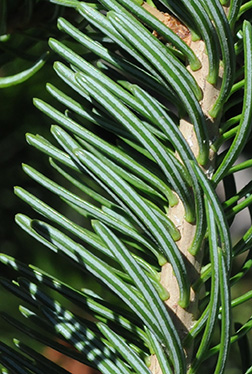

Subalpine fir is the smallest of western 'true firs.' It is a dominant competitor in environments offering cool summers, cold winters, and deep snowpacks. Many species of wildlife use subalpine fir as a food source, including moose and several species of birds and small mammals.
Light ![]()
Clearcutting, shelterwood, single tree and group selection all work, depending on associated trees. In spruce-fir stands, shelterwood and single tree selection will favor subalpine fir. In stands with other western firs and/or mountain hemlock, clearcutting and group selection will favor subalpine fir.
Water
![]()
![]()
![]()
![]()
![]()
![]()
Grows at high elevations, often near treeline. Forms small pure stands but often mixed with other high elevation conifers; very tolerant of shade and understory conditions, but also grows in the open.
Growth
![]()
Size
![]()
When mature 40 to 100 feet tall and 1 to 2 feet in diameter. Very narrow crown of dense foliage; often spire-like with branches to the ground.
Timber Value ![]()
Subalpine fir is used for building construction, boxes, crates, sashes, doors, and frames.
Wildlife Value ![]()
The relatively large seeds offer birds and small animals an efficient food source. Moose browse the stems and foliage in Montana, Wyoming, and Idaho.
Attracts squirrels, deer mice, mountain voles, chipmunks, moose, blue grouse, other birds
Fun Facts
Subalpine fir is an important species in protecting high elevation watersheds in the western United States. Its lumber is used for a wide variety of products. A variety of the tree known as corkbark fir, because of its thick, soft bark, occurs in the southern Rocky Mountains. Some taxonomists separate subalpine fir into two distinct species; A. lasiocarpa of the Pacific Coast and A. bifolia of the Rocky Mountains. Subalpine fir grows in areas with the highest water yields across the west. Grizzly bears in Yellowstone National Park occasionally strip away the bark of subalpine fir and feed on exposed inner tissue.
Latin Meaning
Abies: ancient name - rising or tall tree, name for the European fir /
lasiocarpa: rough fruit (cones)
Home - I.D. Fact Sheet - USDA Silvics Manual - Additional Silvics
Landowner Factsheets © 2004 Virginia Tech Forestry Department, all rights reserved. Text, images, and programming by: Dr. Jeff Kirwan, Dr. John R. Seiler, John A. Peterson, Edward C. Jensen, Guy Phillips, or Andrew S. Meeks.